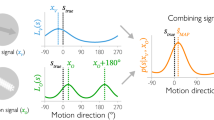Abstract
MACKAY1 rediscovered a striking experimentally produced visual hallucination. After inspection of stationary black-and-white stripes, a uniform test field is apparently filled with particles in chaotic streaming motion at right angles to the orientation of the stripes2. A great deal has since been discovered about pattern-analysing channels in the human brain, and much of this information has been gained from the study of visual illusions and after-effects. The streaming hallucination, however, has never been properly explained3, and is now not much more than a curiosity in the textbooks. In this paper an explicit model of the streaming after-effect is proposed, and from it some new subjective after-effects are derived.
This is a preview of subscription content, access via your institution
Access options
Subscribe to this journal
Receive 51 print issues and online access
$199.00 per year
only $3.90 per issue
Buy this article
- Purchase on Springer Link
- Instant access to full article PDF
Prices may be subject to local taxes which are calculated during checkout
Similar content being viewed by others
References
MacKay, D. M., Nature, 180, 849–850 (1957); 181, 362–363 (1958).
Hunter, W. S., Psych. Rev., 22, 479–489 (1915).
Werner, G., in The Neurosciences, Third Study Programme, 171–183 (MIT, Cambridge, Massachusetts, 1974).
Ikeda, H., and Wright, M. J., Expl Brain Res., 22, 363–383 (1975).
Kulikowski, J. J., and Tolhurst, D. J., J. Physiol., Lond., 232, 149–162 (1973).
Levinson, E., and Sekuler, R., J. Physiol., Lond., 250, 347–366 (1975).
Hubel, D. H., and Wiesel, T. N., J. Physiol., Lond., 195, 215–243 (1968).
Hubel, D. H., and Wiesel, T. N., J. comp. Neur., 158, 267–294 (1974).
Hess, R., Negishi, K., and Creutzfeldt, O., Expl Brain Res., 22, 415–419 (1975).
Wohlgemuth, A., Br. J. Psych. monogr. suppl., 1, (1911).
Sutherland, N. S., Q. Jl exp. Psych., 13, 222–228 (1961).
Barlow, H. B., and Hill, R. M., Nature, 200, 1347 (1963).
Georgeson, M. A., thesis, Univ. Sussex (1975).
Author information
Authors and Affiliations
Rights and permissions
About this article
Cite this article
GEORGESON, M. Antagonism between channels for pattern and movement in human vision. Nature 259, 413–415 (1976). https://doi.org/10.1038/259413a0
Received:
Accepted:
Issue Date:
DOI: https://doi.org/10.1038/259413a0
This article is cited by
-
Release from inhibition reveals the visual past
Nature (1999)
-
A neurophysiological model for anomalous correspondence based on mechanisms of sensory fusion
Documenta Ophthalmologica (1981)
-
Antagonism between visual channels for pattern and movement?
Nature (1976)
Comments
By submitting a comment you agree to abide by our Terms and Community Guidelines. If you find something abusive or that does not comply with our terms or guidelines please flag it as inappropriate.



